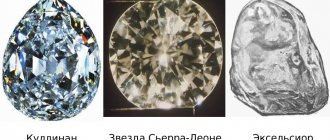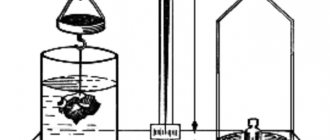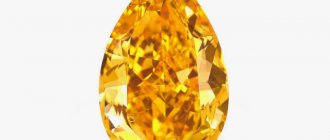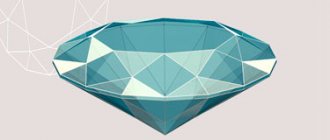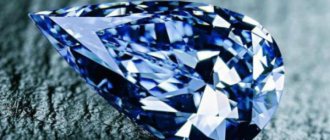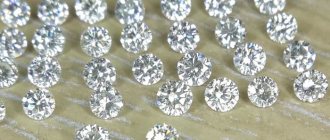The modern world is distinguished by its pragmatism. In it, every thing has a price, so if you want diamonds - the most beautiful stones in the world, you should learn to evaluate them and determine their true value. And for this you need to know what a carat is and how diamonds are measured. Only a professional jeweler can comprehensively evaluate diamonds using the 4C system. It is used to determine the value of a stone by color (color), transparency (clarity), quality of cut (cut) and weight (carat). A person who is far from jewelry art is unlikely to find out how close a new acquisition is to perfection. But anyone can determine the value of a diamond, because the main thing is to know what is measured in carats and the weight of 1 carat.
Since 2002, Russia has had current standards and norms for the evaluation of precious stones. Technically, the process itself can be divided into several stages:
- Assessment of cut quality . Round or oval stones with 17 to 57 facets are in great demand.
- Stone weight.
- Color – from colorless to brown. Here jewelers do not give precise characteristics. As a rule, the epithets “saturated”, “barely perceptible”, “virtually imperceptible”, etc. are used.
- Cleanliness – presence of chips, defects, cracks, etc.
Only after this is the true value of a particular stone determined.
What is carat?
It is not known why the carat is a unit of measurement for precious stones. It is believed that in ancient times barley grains or acacia seeds Ceratonia siliqua were used to determine weight. But at the beginning of the 20th century, the International Committee of Weights and Measures legalized this unit of measurement for the weight of precious nuggets.
Now we can answer what a 1-carat diamond looks like - the cross-sectional size of its circumference is 0.64 cm, its weight is 0.2 g, it has 57 facets and a high degree of ray reflectivity.
From here, all diamonds are classified as follows:
- Diamonds weighing 1 carat or more are classified as large
- average diamonds weigh up to 0.99 carats;
- stones weighing less than 0.29 carats are considered small ;
- the remaining pebbles are called diamond dust .
Gold earrings with diamonds, SL;
gold ring with diamonds, SL (prices via links) Large diamonds are rare and practically never come on sale. Nuggets of large size and weight can only be seen at auctions. Diamonds of 25 units and above are very rare guests; they are given their own names.
Round cut stones, in turn, are classified as follows:
- Those with ideal processing quality belong to category A.
- Distinguished by very good processing quality – classified as category B.
- Good processing quality is assigned to category B.
- Medium quality cut diamonds – G.
The higher this indicator, the brighter the sparkle of the diamond. However, in small stones this is practically not noticeable. Each cut diamond is subject to certification. Finished stones are included in the exchange listing, and from this moment on, its cost is determined by the pricing policy of the Diamond Exchange. It is simply impossible to buy a stone cheaper than the price indicated in the exchange listing.
Prices per unit weight of diamond are the same all over the world.
At the beginning of the 20th century, a stone weighing 3106.75 carats, called Cullinan, was found in one of the South African diamond deposits. Initially it had parameters of 100x65x50 mm, but since it had defects, it was split into small pebbles.
The weight of 1 carat is 0.2 grams. The approximate ratio of the diameter of a Circle cut diamond is 57 facets to its weight.
The table below shows the approximate weight of 1 diamond in various sizes. Dispersion is the number of diamonds in 1 carat. This table is most often used by jewelry professionals; after this table there is a more detailed description of the ratio of the diameter of a diamond to its weight.
| Diamond size (number of diamonds in 1 carat) | Diamond diameter, mm | Diamond weight, carat |
| 400-200 | 0.90-1.10 | 0.002-0.005 |
| 200-120 | 1,15-1,25 | 0.005-0.008 |
| 120-90 | 1,30-1,43 | 0.008-0.011 |
| 90-60 | 1.45-1.64 | 0.011-0.0166 |
| 60-40 | 1.65-1.88 | 0.0166-0.025 |
| 40-30 | 1.89-2.05 | 0.025-0.033 |
| 30-25 | 2.10-2.20 | 0.033-0.039 |
| 25-20 | 2.21-2.36 | 0.04-0.05 |
| 20-15 | 2.40-2.60 | 0.05-0.07 |
| 15-10 | 2.66-2,95 | 0.07-0.10 |
| 10-7 | 3.00-3.30 | 0.10-0.14 |
| 7-6 | 3.35-3.55 | 0.14-0.17 |
| 6-5 | 3.60-3.75 | 0.17-0.20 |
| 5-4 | 3.80-4.05 | 0.20-0.25 |
| 4-3.4 | 4.10-4.30 | 0.25-0.299 |
| 0.30-0.39 | 4.35-4.70 | 0.30-0.39 |
| 0.40-0.49 | 4.75-5.10 | 0.40-0.49 |
| 0.50-0.59 | 5.15-5.40 | 0.50-0.59 |
| 0.60-0.69 | 5.45-5.70 | 0.60-0.69 |
| 0.70-0.79 | 5.75-5.95 | 0.70-0.79 |
| 0.80-0.89 | 6.00-6.20 | 0.80-0.89 |
| 0.90-0.99 | 6.25-6.40 | 0.90-0.99 |
| 1.00-1.24 | 6.45-6.90 | 1.00-1.24 |
| 1.25-1.49 | 6.95-7.35 | 1.25-1.49 |
Below is a list of diamond girdle diameters and its likely weight. Below is a description of the ratio of round diamonds to carat weight of the stone.
The weight of a diamond based on the diameter of its girdle is indicated as approximate, since it may differ depending on the quality of the cut.
| Diamond Diameter (mm) | Diamond Weight (carat) |
| 1.0mm diamond diameter | 0.005 carat |
| 1.3mm diamond diameter | 0.01 carat |
| 1.5mm diamond diameter | 0.015 carat |
| 1.7mm diamond diameter | 0.02 carat |
| 1.8mm diamond diameter | 0.025 carat |
| 2.0mm diamond diameter | 0.03 carats |
| 2.2mm diamond diameter | 0.04 carat |
| 2.4mm diamond diameter | 0.05 carat |
| 2.5mm diamond diameter | 0.06 carat |
| 2.7mm diamond diameter | 0.07 carat |
| 2.8mm diamond diameter | 0.08 carat |
| 2.9mm diamond diameter | 0.09 carat |
| 3.0mm diamond diameter | 0.10 carat |
| 3.1mm diamond diameter | 0.11 carat |
| 3.2mm diamond diameter | 0.12 carat |
| 3.3mm diamond diameter | 0.14 carat |
| 3.4mm diamond diameter | 0.15 carat |
| 3.5mm diamond diameter | 0.16 carat |
| 3.6mm diamond diameter | 0.17 carat |
| 3.7mm diamond diameter | 0.18 carat |
| 3.8mm diamond diameter | 0.20 carat |
| 3.9mm diamond diameter | 0.22 carats |
| 4.0mm diamond diameter | 0.25 carat |
| 4.2mm diamond diameter | 0.30 carat |
| 4.4mm diamond diameter | 0.33 carats |
| 4.5mm diamond diameter | 0.35 carat |
| 4.6mm diamond diameter | 0.38 carat |
| 4.8mm diamond diameter | 0.40 carat |
| 5.0mm diamond diameter | 0.50 carat |
| 5.4mm diamond diameter | 0.60 carat |
| 5.5mm diamond diameter | 0.63 carats |
| 5.6mm diamond diameter | 0.65 carats |
| 6.0mm diamond diameter | 0.80 carat |
| 6.4mm diamond diameter | 0.95 carats |
| 6.6mm diamond diameter | 1.05 carats |
| 6.8mm diamond diameter | 1.17 carats |
| 7.0mm diamond diameter | 1.25 carats |
| 7.2mm diamond diameter | 1.40 carats |
| 7.5mm diamond diameter | 1.55 carats |
| 7.8mm diamond diameter | 1.75 carats |
| 8.0mm diamond diameter | 2.00 carats |
| 8.4mm diamond diameter | 2.15 carats |
| 8.6mm diamond diameter | 2.25 carats |
| 9.0mm diamond diameter | 2.75 carats |
| 9.4mm diamond diameter | 3.00 carats |
| 9.6mm diamond diameter | 3.15 carats |
| 9.8mm diamond diameter | 3.35 carats |
| 10.0mm diamond diameter | 3.50 carats |
| 10.2mm diamond diameter | 3.75 carats |
| 10.4 mm diamond diameter | 4.00 carats |
| 10.6mm diamond diameter | 4.25 carats |
| 10.8mm diamond diameter | 4.50 carats |
| 11.0mm diamond diameter | 4.75 carats |
| 11.2mm diamond diameter | 5.00 carats |
| 12.0mm diamond diameter | 6.50 carats |
Diamond weight in carats
Let's fix it: The weight of a diamond is measured in carats - this is approximately 200 milligrams.
By the way, in ancient times, carats were the name given to the seeds that were placed on the opposite scale when weighing a stone.
Diamonds are divided into small, medium and large:
Small: up to 0.30 carats Medium: from 0.30 to 1 carat. Large: above 1 carat.
How to determine the carat value of a diamond?
There are several ways to determine the carat value of a diamond:
- weighing;
- according to the formula;
- using special tables.
Each method determines carat content with some degree of accuracy.
The weight of small pebbles is estimated by weighing. For this purpose, special scales are used - microscales. The precision of diamond weighing is determined to thousandths. In the same way, you can determine a diamond of 3 carats, 1 carat, or the weight of medium stones.
Today on the market the cost of a 1-carat diamond of the highest quality reaches 20 thousand dollars.
To determine the price of a gemstone, the cost per unit of measure should be multiplied by its weight.
Diamond weight measure
The carat is an international unit of measurement for the weight of jewelry. Moreover, this applies not only to stones, but also to precious metals. But the system for converting carats to grams is different in both cases. In the situation with diamonds, one carat is equal to 0.2 milligrams. This has been established since 1907 in Paris by the International Committee of Weights and Measures.
Diamond
The origin of the name of the weight measure is interesting. Previously, standards did not exist, and using conventional scales it was not possible to measure the mass of a diamond or diamond - the scales simply did not respond to small numbers. Therefore, they came up with the idea of comparing precious stones with an acacia grain, of which there were many and it was possible to calculate the weight of one piece. Since acacia grew on all continents, this method of measurement became worldwide and approximately the same. The real carat value of stones has long been calculated, but the name of the unit has been preserved.
Those who want to buy a diamond need to know that its cost does not always depend on the carat of the stone. Of course, finding a large diamond in natural conditions is a real success, and such a stone will be very valuable, but there are still other factors that affect the value. Among them:
- cutting, depending on the professionalism of the jeweler;
- the color of the stone, which varies from bluish to yellow shades;
- the purity of the stone and the absence of defects that spoil not only the appearance, but also the strength of the diamond;
- diamond shape.
Therefore, a jewel of several carats will not always cost more than a smaller but pure analogue. Because of this, it is even approximately impossible to calculate the price of one carat.
Depending on their weight, the following diamonds are distinguished:
- diamond chips - particles that weigh up to 0.01 carats;
- Small diamonds are considered to be stones up to 0.29 carats;
- medium diamonds - up to 0.99 carats.
These are the options that can be purchased independently in the form of stones or already mounted on jewelry. But stones up to 6 carats in size can only be bought at auctions. There are also nuggets that reach sizes up to 25 carats. In such cases, diamonds may not even be cut, but simply stored in their pure form and given their own names.
Match between weight and size
When trying to find out the size of a stone, you should assume that the diameter of the diamond, which has a round shape, is taken as a basis. The size of diamonds is directly related to the number of their facets and weight. All diamonds are processed by hand, so they can vary greatly in size, but be identical in weight. Interestingly, large diamonds with multiple facets can weigh less than smaller stones.
Although size is not taken into account in the evaluation, there is a special scale for suitability. It allows you to establish the relationship between the weight and size of stones belonging to the “A” cut group (clean diamonds, distinguished by their large weight, special brilliance and significant cost).
Thus, the size of a diamond belonging to the specified cut group must correspond to the following values:
- a 0.2 carat diamond measures 3.8 mm;
- the 0.25 carat gem measures 4.1 mm;
- a diamond weighing 0.33 carats measures 4.4 mm;
- the size of a gemstone weighing 0.5 carats does not exceed 5.1 mm;
- the size of a stone weighing 1 carat is 6.4 mm;
- A 2 carat diamond can be up to 8.1 mm in size;
- a 3-carat stone does not exceed 9.4 mm in diameter;
- The 15 carat stone has a diameter of 1.6 cm.
Matching the carat of diamonds to the size of the stone
There are special catalogs that record the color, weight, clarity and size of diamonds. Knowing the size of a diamond, you can determine its weight, even without having the necessary scales at hand to weigh it. To do this, you need to measure the height and diameter of the stone in mm. The ratio of height to diameter, expressed as a percentage, will be the desired weight. If the diamond is of truly high quality, then the resulting figure will not exceed 62.5%.
It is almost impossible to determine the size of a piece of jewelry by eye. Some diamonds are so small that it is impossible to distinguish a 2-carat diamond with a diameter of 8.1 millimeters from a 1.95-carat diamond with a diameter of 7.9 millimeters without special equipment.
World record holders
The size of diamonds in most cases does not have a decisive impact on the cost, of course, unless we are talking about huge stones, such as:
- "Star of Africa" Diamond also known as "Cullinan". It was found in South Africa in 1905. The weight of the stone was 3106 carats, 100 mm in length, 65 in width and 50 in height. Since the structure of the diamond was not ideal, it was split into several pieces, the largest of which are the property of the British Crown.
- "Our light." The diamond was found in Botswana in 2015. It is recognized as the second largest and heaviest diamond after the Star of Africa diamond. The diamond measures 6.5 cm in length, 5.6 cm in width and 4 cm in height.
- "Exilior". The diamond was found in South Africa in 1893. The weight of the stone was at least 995.2 carats. After splitting, 21 diamonds were made from it. The Exilor was at least 3 cm in diameter. Before the Star of Africa was found, it was considered the largest diamond ever found.
- "Great Mogul". A 787-carat diamond was found in medieval India. Its exact size in mm cannot be determined, since the stone was split and traces of it were lost.
Determining the size of a diamond is impossible without knowing its length, width, elongation, area size, and diameter. Also important are the height of the girdle, the angle of inclination of the edges of the top, the angle of inclination of the edges of the bottom, the width of the cut part of the girdle and the angle of the cut.
These terms are familiar to every professional. Without sufficient competence in jewelry making, it is better not to try to do it yourself. You can miscalculate the price and overpay where you shouldn’t.
